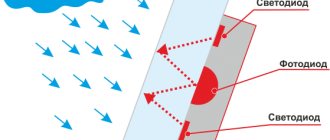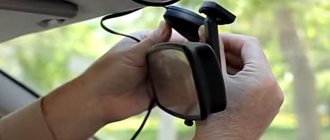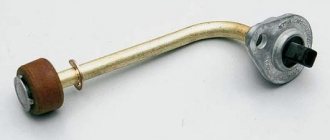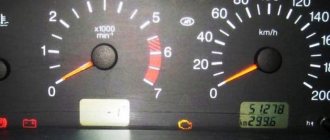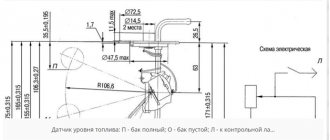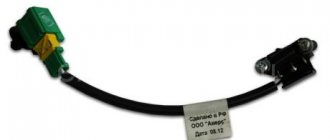July 15, 2016 Lada.Online 53 896 6
Many modern Lada cars (for example, Granta, Kalina, Vesta or XRAY) have a standard rain sensor, which is installed from the factory. On machines that do not have this option, you can install it yourself. Let's look at the features of connecting the DDA rain sensor on different Lada models.
Why do you need a rain sensor?
The described device is a device that detects the appearance of precipitation and turns on the wipers. Typically, the sensor also reacts to light levels and is used to automatically turn on the headlights.
Rain sensor
This device is designed to solve several problems:
- determining the presence of rain or snow;
- turning on the wipers when it rains;
- determining the degree of contamination of the windshield;
- turning on the headlights if the sensor is also designed to detect the level of illumination.
The described device is installed between the windshield and rearview mirror. The rain sensor is designed to create safer conditions when driving in the city or on a busy highway. If it begins to rain or snow during heavy traffic, the driver has to make unnecessary movements to turn the wipers on and off, taking his attention from the road. This contributes to loss of attention and can lead to an accident. In addition, the device allows for excellent visibility in the presence of large amounts of precipitation.
Rain sensors have several disadvantages:
- False or inappropriate positives. In some cases, just one drop causes the wipers to turn on, although the rest of the glass remains dry. At the same time, the sensor often does not work when part of the glass is filled with water and dirt, but the drops do not fall into the coverage area of the device.
- Turning on the wipers without windshield washer. Because of this, dirt is smeared across the surface, causing poor visibility.
- Triggered due to defects in the windshield. The presence of scratches and other defects on the surface may cause the device to malfunction.
- Response delay. In some cases, the rain sensor is activated within 1-2 seconds after rain drops appear on the windshield.
Advice!
To avoid such problems and pre-set the sensor to the desired level of sensitivity, just splash water on the place where the sensor is installed. If it works correctly, the wipers will automatically turn on.
Installing a rain sensor
The rain sensor is mounted under the windshield on the back of the rear view mirror. During installation of the device, the following nuances are taken into account:
- The sensor must be located on the windshield in such a way that it does not interfere with the driver's view of the road. It is important to install it in an area that is cleared by the wipers while they are running. Otherwise, the device may not function correctly.
- There should be no cracks or other defects in the area where the sensor is located, since the efficiency of its operation depends on this.
- Before attaching the device, you need to make sure that the wipers effectively clean the windshield and do not leave dirt.
The sensor can be installed either at a service center or independently. Moreover, it is not at all difficult. No special tools are required for installation.
Below we provide instructions for installing a simple rain sensor DDA-35.
First you need to “aim” - select a place on the inside of the windshield where the sensor will be glued. As mentioned earlier, it should not interfere with the driver's view. For beauty, it is advisable to check the location and install the sensor at the top in the middle, next to the mirror mount.
Purchased rain sensors most often come with a special cloth for wiping and degreasing the glass. Thanks to this, the sensor is attached better.
If such a napkin is not included in the kit, you can use any glass napkin.
Carefully wipe the area on the windshield where we will glue the rain sensor.
We remove the protective film from the inside of the sensor, thereby revealing the fasteners that will hold the sensor on the glass.
After this, apply the rain sensor to the selected place on the glass and carefully press the device against the glass. We try to make sure everything goes smoothly, since we won’t have a second chance. With each disconnection, the holder will stick to the surface worse and worse.
We push the wire from the sensor under the headliner.
If there is not enough space under the upholstery, then slightly loosen the screws securing the visor.
Remove the cover plate from the rack and lay the wire under it. After this we put the cover back on.
Let's go lower. Carefully push the cable under the rack seal.
We open the fuse box (in different models it is located in different places), and install the rain sensor in place of the windshield wiper control relay (be sure to follow the markings and the position of the key). If we don’t know exactly where to install the relay, look in the documentation.
If necessary, the remaining cable can be wound up and left in the mounting block.
This completes the process of installing a rain sensor on a car. All that remains is to check its performance by splashing water on the windshield (with the car's ignition on, of course).
Checking the functionality of the rain sensor
You can also watch a video about installing a rain sensor:
After connecting the device, the wipers can be controlled manually. This may be necessary when moisture gets onto the glass from under the wheels of a car moving in front and does not reach the sensor’s coverage area. In this case, the driver turns on the wipers manually.
It is necessary to set up the device immediately after installation, so as not to be distracted by such actions while driving. The DDA-35 has 3 operating modes - standard, rain and snow. Modes are switched by pressing a single button one by one.
The built-in factory rain sensors are adjusted using the steering column switch. The power handle standardly has 5 positions (sometimes more and less). In position “0” the device is turned off. Numbers from 1 to 4 indicate the degree of sensitivity of the sensor. When you turn on the device in mode 4, it will operate in maximum sensitivity mode. To turn it off, simply turn the knob to position 0.
The rain sensor is adjusted using the steering column switch
Advice!
In dry weather, it is recommended to turn off the device, as it may operate periodically. An example is insects getting on the windshield.
How does a rain sensor work?
How the rain sensor works
The described device consists of an LED and several photosensitive elements (photodiodes). The light emanating from the LED is reflected from the glass surface and returned to the light-sensitive elements. If there is rain or snow on the surface, the degree of reflection changes and the sensor turns on the wipers.
The more wet the windshield is, the less refracted light will be reflected. Photocells react to the change and after that the wipers turn on. This is why false alarms may occur when insects get on the glass or if there are defects on the surface. To prevent untimely activation of the wipers, it is enough to turn off the sensor in dry weather and install the device only on undamaged glass.
Device
The operation of the sensor is determined by the comparative function of the optical properties of the windshield in different weather conditions using an infrared beam.
It contains two LEDs : emitting and receiving. The operating algorithm depends on the surface of the glass and how dirty it is. Based on the analysis of incoming information, the system makes a decision about the need to turn on the windshield wipers.
How to turn the rain sensor on and off
Turning on the factory rain sensor after installation is quite simple - to do this, you need to turn the steering column lever to positions from 1 to 4. It turns off when you switch the lever to position 0. If problems arise in the operation of the sensor, you should not try to turn it off yourself if you don’t know how to do it correctly.
Example of setting up a rain sensor. To turn it on, you must move the steering column lever to position 1. The dial A must be set in accordance with the desired sensitivity (bottom - minimum, top - maximum). To turn off the rain sensor, move the steering column lever to position 0.
The main mistake many drivers make is to turn off the device in the simplest way - by cutting the wire. Such actions may cause a malfunction of the on-board power supply control unit. If the sensor does not respond to small drops, you should first unscrew the knob to position 4, at which it will operate in maximum sensitivity mode.
To safely disconnect the sensor, simply remove the connector from it. In this case, an error will be displayed in the on-board power supply unit. If you need to completely turn off the device, you should contact a car service.
Many rain sensors are universal and can be installed on any car. They all work on the same principle, so any driver can configure the device independently.
Principle of operation
Any transition between substances in contact forms an optical boundary. All types of electromagnetic radiation are refracted on it, that is, they change the angle of propagation and energy properties. Part of the beam passes through the boundary, while the other is reflected and returned to an optically denser substance.
For example, fiber-optic communication lines operate on this principle, where at a certain angle light cannot escape the glass and spreads over long distances without loss.
The most suitable frequency range turned out to be infrared (IR) radiation. Its spectrum lies below the limit of visible light. Such radiation is felt only as heat, and therefore is considered thermal; the eye does not notice it. However, this is a wave with properties close to light, and therefore works according to optical laws.
How much does a rain sensor cost?
The cost of many rain sensors is about 2 thousand rubles. The price depends on the sensitivity of the device, as well as on whether the electronic relay is built into the car or is removable. The method of connecting the sensor depends on this.
Many universal models cost no more than 2 thousand rubles. Such sensors are the most common and are installed on a wide variety of machines. If the sensor is installed at a service center, specialists select the most suitable device for the car.
5/5 — (4 votes)
Station wagons
In addition to the sensor models that come standard, there are also models compatible with most brands and models of cars. They can also be installed on domestically produced cars - VAZ, UAZ. Manufacturers offer sensors ranging from the simplest DDA-15 to a two-in-one device - the rain and light sensor DDA-65.
The kit includes a relay that needs to replace the standard wiper relay. It has three modes including snow and rain. Factory kits installed on cars can have 5 operating modes.
